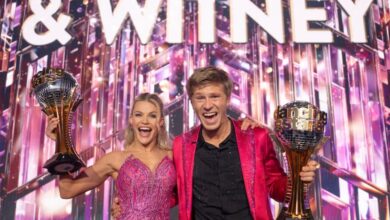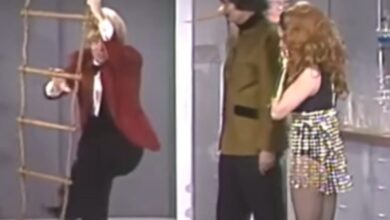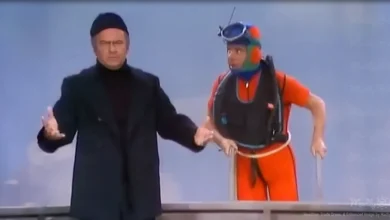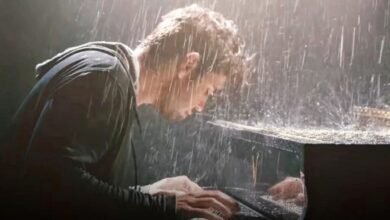Aerosmith and YUNGBLUD Turn “Problems” into a Digital Arena Spectacle with Their 26 November 2025 Visualizer
When Aerosmith and YUNGBLUD released the “Problems (Official Visualizer)” on 26 November 2025, it didn’t feel like a standard YouTube upload—it played more like a digital arena debut. From the very first beat, the visualizer created the sensation of a real-time performance, blending classic rock grit with the restless pulse of modern alt-pop. It made the collaboration feel immediate, urgent, and larger than the screen itself.
The drop captured instant attention because it acted less like a simple video and more like the continuation of a musical dialogue that had been building all year. With Aerosmith returning after a long studio hiatus and YUNGBLUD powering through one of the strongest phases of his career, the visualizer became a bridge between their worlds. It carried the atmosphere of a late-night stadium show, even though every moment existed in pixels.
“Problems,” part of their collaborative EP One More Time, already carried emotional weight before the visualizer’s release. But pairing the track with shifting colors, stylized motion, and cinematic shadows gave it sharper definition. Nothing about it felt excessive; every visual choice mirrored the tension, honesty, and vulnerability embedded in the song itself.
The chemistry between Steven Tyler and YUNGBLUD is one of the visualizer’s standout elements. Their voices don’t clash—they tangle, pull apart, and reunite in a way that resembles two different generations weathering the same emotional storm. Every cut and pulse in the video enhances that push-and-pull, emphasizing their contrast while blending their intensity into a shared frequency.
Joe Perry’s guitar lines hit harder in this visual setting, slicing through the darkness like beams of stage light, while the rhythm section drives forward with a headlong rush. The visualizer matches that momentum with wide, sweeping movements and sharp flashes that give the feeling of a virtual concert where everything threatens to burst past its frame.
When YUNGBLUD leans into the track’s raw confessions, the visuals tighten and darken, amplifying the sense of a young artist pushing through the pressure of visibility. The neon tones, flickering distortions, and bursts of static reflect the emotional overload at the core of his performance, making the screen feel like a window into his internal storm.
Then Steven Tyler enters with his trademark command, immediately shifting the tone. His presence lifts the visual field—lights widen, colors brighten, and the atmosphere swells. Tyler’s vocals add weight and steadiness, anchoring the song with the unmistakable authority of someone who has lived every word of the story being told.
The interplay between the two artists becomes even more dynamic as the song unfolds. The visualizer pulses in rhythm with their voices, capturing a tug-of-war between youthful urgency and seasoned conviction. It’s a pairing that might seem unlikely on paper but feels completely natural when seen and heard together.
As the track builds, the visualizer leans into its theatrical strengths. Shapes glitch, expand, and rush across the frame in sync with the rising vocal layers. It feels like an explosion of digital stage lights during a massive chorus, giving the release the momentum of a live show rather than a studio supplement.
Midway through, the visuals slow and cool, offering a moment of emotional suspension. It feels like the track pauses to breathe—letting the tension settle long enough to make the final surge hit even harder. When the chorus roars back, the entire screen bursts with motion, perfectly matching the song’s emotional peak.
The narrative flow of the visualizer stands out. Each section feels like a chapter, shifting the tone and energy as the song progresses. This structure elevates the track, turning the entire release into a small cinematic arc rather than a simple visual pairing. It carries the rhythm of storytelling, not just music.
As the final notes fade, the visualizer dissolves instead of simply cutting out. The lingering glow fits the theme—“Problems” doesn’t resolve its emotions; it acknowledges them. The ending leaves the same sensation as the last echo of a concert fading into the night.
Fan reactions were immediate and intense. Within hours of the release, listeners from both generations filled the comment sections—some praising the emotional heaviness YUNGBLUD brought, others celebrating Aerosmith’s unmistakable imprint on the track’s power and scale. The blend that once seemed experimental now feels seamless.
In the end, the “Problems” visualizer becomes more than a promotional piece—it’s a fully realized extension of the song’s emotional core. By turning sound into shape, motion, and atmosphere, Aerosmith and YUNGBLUD created a release that feels alive, cinematic, and unmistakably built for 2025.
And when the last flicker slips into darkness, the lingering feeling is the same as stepping out of a roaring arena into cool night air—the sense that something loud, human, and unforgettable has just taken place.





